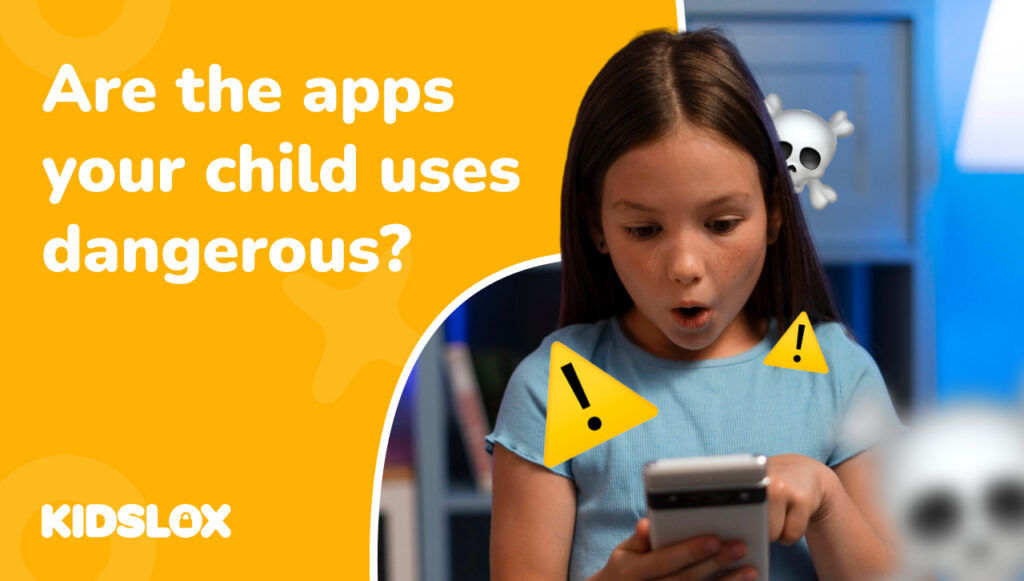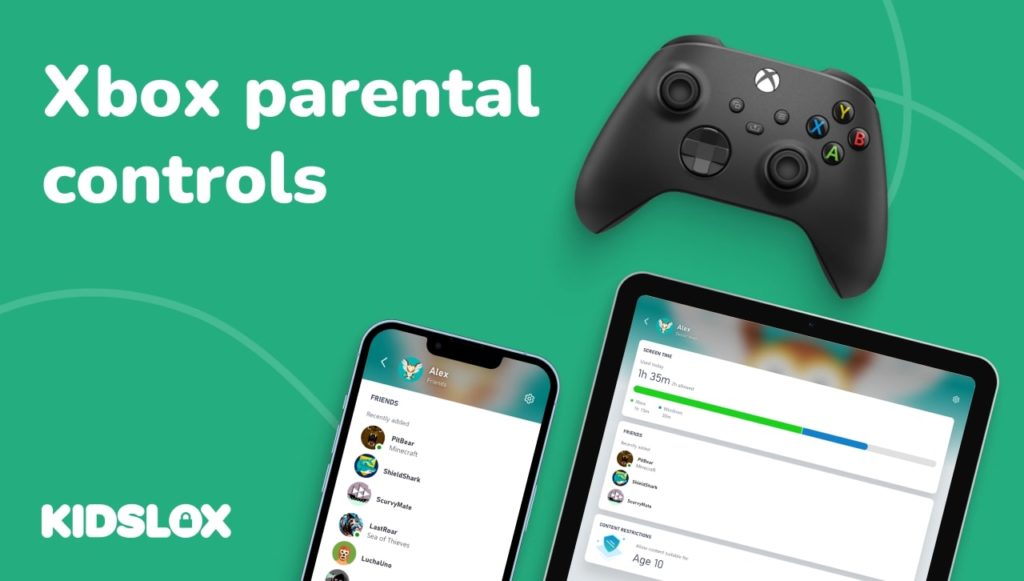Key Takeaways:
- Dangerous apps share many common red flags: excessive permissions, stranger connections, disappearing content, and other features designed to avoid monitoring.
- Social media apps like TikTok, Instagram, and Snapchat may expose children to cyberbullying, inappropriate content, and privacy risks.
- Anonymous messaging apps (Kik, Discord, Yik Yak) remove accountability and may attract predators who can create fake accounts without verification.
- Gaming apps, vault apps, and random video streaming apps also pose danger to children who may not know how to discern between safe and dangerous content.
- Parental control solutions like Kidslox can block entire app categories, filter 4+ million inappropriate URLs, and alert parents to new downloads
Have you ever picked up your child’s digital device and noticed page after page of apps?
Downloading apps is quick and easy these days, and new ones are launching every single day. By the time you’ve learned about one app or platform, it’s likely your kid’s already moved on to three others.
Rather than playing an endless game of catch-up with individual app names, knowing the types of dangerous apps – and what to look out for in each type – can help you gain a bit more control over the chaos.
Recent surveys of parents found that 46% are “extremely worried” that their children are encountering inappropriate content online.
The only problem? Most feel overwhelmed trying to monitor every single app.
Let’s change that. By recognizing patterns in how unsafe apps operate, you can spot potential risks even in apps you’ve never heard of.
What’s a Dangerous App?
Before we look at specifics, let’s define what we mean when we say “dangerous app.”
All apps are simple in theory. They’re applications that allow you to access certain content for a specific purpose.
Your phone app lets you make calls. A banking app allows you to access your money online. Games (though often nefarious in their own right) let you distract yourself for hours.
So what makes the shift from harmless to harmful? There are a few key things that turn apps from fun and useful tools to potential threats.
Apps That Request Excessive Permissions
Does a calculator app really need access to your contacts, camera, and location?
When an app asks for permissions that don’t match its stated purpose, that’s a red flag. Dangerous apps often request broad access to harvest data or enable hidden features.
Apps That Connect Kids With Strangers
Any app that randomly pairs users or allows unrestricted contact from unknown people creates opportunities for predatory behavior. The anonymity of the internet emboldens bad actors who wouldn’t approach children in real life.
Apps That Hide or Delete Content
Features that make messages disappear, hide photos, or disguise the app’s true purpose prevent parents from monitoring their child’s digital activity. Secrecy and deception are built into these apps’ DNA.
Apps With Unmoderated User Content
When anyone can post anything without review, children are exposed to inappropriate material, hate speech, and harmful ideologies. The lack of content filtering makes these digital spaces unsafe for developing minds.
Apps That Bypass Parental Oversight
Whether through encryption, fake interfaces, or operating outside traditional app stores, these platforms are designed to evade the very safeguards parents put in place.
Social Media and Video Sharing Apps
Social media apps remain the most common entry point for online dangers. These platforms combine multiple risk factors: public profiles, private messaging, and algorithm-driven content that can quickly spiral into inappropriate territory.
Cyberbullying happens most frequently on these platforms, where comments, shares, and screenshots can amplify harmful messages.
Body image issues particularly affect young users, with internal research showing platforms like Instagram can worsen these concerns for one in three teenage girls.
The disappearing content feature, popularized by Snapchat (and now on apps such as Instagram, WhatsApp, and more), creates a false sense of security.
Kids may share photos or messages they wouldn’t normally send, believing they’ll vanish forever. In reality, screenshots and screen recordings make nothing truly temporary online.
Apps to Watch Out For
The major players include TikTok, Instagram, and Snapchat, but don’t overlook platforms like YouTube, Tumblr, and Twitter/X.
Newer apps like Threads, BeReal, and Yubo are gaining traction among teens, while VSCO and Triller offer similar risks with less parental awareness.
Each platform has unique features that require attention. TikTok’s algorithm can quickly lead kids from innocent dance videos to dangerous challenges or explicit content.
Instagram’s Reels and Stories create multiple ways for strangers to contact your child. Snapchat’s Snap Map broadcasts your child’s location to their entire friend list by default.
What Parents Should Know About Social Media Apps
Most social platforms default to public profiles for new users. Take time to adjust privacy settings immediately after your child creates an account. Look for:
- Profile visibility (set to private/friends only)
- Who can send messages or friend requests
- Location sharing settings
- Comment permissions
- Content filtering options
Remember that age verification on these platforms relies on self-reporting. A child can easily claim to be 16 or 18 to bypass restrictions. This makes your involvement even more critical.
Anonymous and Secret Messaging Apps
Anonymous messaging apps remove the natural accountability that comes with identity. While this may seem great for children and teens who want to protect their privacy, it’s a breeding ground for cyberbullying, as aggressors face no real consequences for their actions.
Predators actively seek out these anonymous platforms because they can create multiple fake profiles and approach children without leaving a digital trail.
Encrypted messaging adds another layer of concern – even if you have access to your child’s device, you can’t see what’s being shared.
Apps to Watch Out For
Kik remains popular among teens specifically because it doesn’t require a phone number, just a username.
Discord, originally designed for gamers, has evolved into a massive network of unmoderated servers where anyone can interact with your child.
Apps Yik Yak and Ask.FM take anonymity further by encouraging users to share secrets or ask questions without revealing their identity. Other, newer apps include Tellonym, Sarahah, and Whisper.
Wizz markets itself as a way to “meet new friends,” but essentially connects strangers for chatting. Any app promoting anonymous connections should raise immediate red flags.
Red Flags for Parents
So, what should you be watching for? Look for these warning signs in any messaging app:
- No real name or phone number required
- “Disappearing” or “self-destructing” messages
- Anonymous posting or question features
- Encrypted or “private” messaging that blocks monitoring
- Marketing that emphasizes secrecy or privacy from parents
If an app’s main selling point is that “no one will know,” it doesn’t belong on your child’s phone.
Gaming Apps with Social Features
Game apps aren’t just about gameplay – they’re actually social engineering platforms in disguise.
For instance, In-game chat features let players communicate through text or voice, often without any moderation. Your child might think they’re just playing a game, but they’re actually in an open forum with strangers of all ages.
User-generated content adds another risk layer. Games like Roblox let players create their own worlds and experiences, which means your child could encounter inappropriate content that bypassed the game’s official review process.
Apps to Watch Out For
Roblox deserves special attention – it’s incredibly popular with younger kids but has documented issues with predatory behavior and inappropriate content.
Among Us gained massive popularity for its simple gameplay, but it includes unmoderated chat rooms where anything can be said. The same is true for massively popular games like Genshin Impact and Minecraft.
Fortnite, PUBG, and Call of Duty Mobile combine violent content with open voice chat. Even seemingly innocent games can include social features – always check for chat functions before allowing your child to play.
Pay attention to any game that:
- Includes voice or text chat with strangers
- Allows user-generated content
- Has “friend” or team features connecting random players
- Offers in-game currency or rewards for social interaction
Dating and Random Video Chat Apps
These apps have no legitimate place on a minor’s device, yet teens continue downloading them out of curiosity or peer pressure.
Dating apps like Tinder officially require users to be 18, but age verification is minimal – just entering a birthdate.
Random video chat apps pair users with complete strangers for face-to-face conversations. Apps like Omegle and Holla make no attempt to verify age or identity, creating direct pipelines between predators and children. There are also livestreaming apps such as Twitch, LiveMe, and Bigo Live that you’ll want to be aware of.
GPS-based features in apps like Blendr share your child’s exact location with strangers, combining multiple risk factors into one dangerous platform.
Apps That Don’t Belong on Kids’ Phones
Beyond the obvious dating apps (Tinder, Bumble, Hinge), you’ll want to watch out for any app promoting:
- Meeting strangers or “making new friends”
- Random video or chat connections
- Location-based matching
- Adult or “mature” themed content
Even if your teen argues “everyone has it,” these apps violate their own terms of service for users under 18 and expose minors to serious safety risks.
Vault and Hidden Apps
“Vault apps” are some of the most nefarious and dangerous apps out there.
Vault apps are specifically designed to deceive. They appear as innocent calculator apps, note-taking tools, or other utilities on your child’s home screen.
Enter a secret code, however, and they reveal hidden photos, videos, messages, or even other apps.
These apps exist solely to hide content from parents. While privacy is important for developing teens, secret vault apps cross the line from privacy into deception.
Signs Your Child May Be Using Vault Apps
Vault apps can be hard to find – because that’s how they were designed. But there are a few signs you can take note of:
- Calculator apps that require a password
- Duplicate apps (why would someone need two calculators?)
- Apps with generic names like “Calculator%” or “Secret Folder”
- Any utility app asking for photo or media permissions
Popular vault apps include Calculator%, Secret Photo Vault, Best Secret Folder, and Hide It Pro. If you discover one on your child’s device, it’s time for a serious conversation about trust and safety.
How to Keep Your Kids Safe from Dangerous Apps
With this long a list, it’s easy to think that all apps are dangerous. And while there is certainly a risk that any app could be used for malicious purposes, there are steps you can take to keep your kids safe.
1. Always Lead with Communication
Remember, technology isn’t the enemy – unsupervised technology is. That’s why it’s important to have regular, judgment-free conversations with your kids about their online experiences.
Don’t be afraid to ask what apps their friends are using, what they enjoy about certain platforms, and if they’ve ever felt uncomfortable online.
The more comfortable they are with talking with you about these topics, the more likely they are to come to you with concerns.
2. Set Clear Boundaries
Does your family have boundaries in place when it comes to tech? An easy way to build safety guardrails is with a family technology agreement that outlines:
- Which types of apps are allowed
- Time limits for device use
- Consequences for downloading prohibited apps
- When and where devices can be used
3. Perform Regular Check-ins
Schedule weekly device reviews where you sit with your child and look through their apps together. This isn’t about catching them doing something wrong – it’s about staying involved and aware. Make it routine, not punitive.
4. Integrate Parental Control Tools
Parental control apps like Kidslox are powerful allies, but they’re not substitutes for parental involvement. Use monitoring tools to support your rules and conversations, not replace them.
Rather than chasing individual apps, Kidslox lets you block entire categories of potentially harmful apps.
The iOS app blocking feature disables internet access to the most problematic gaming and social media apps, while Android users can block apps entirely.
Kidslox protects against more than just dangerous apps. The system blocks over 4 million inappropriate URLs, ensuring harmful content can’t slip through via web browsers. Google SafeSearch and YouTube Restricted Mode are automatically enabled, adding extra layers of protection.
Online Safety Starts with Digital Literacy
Knowing which apps might be dangerous can help you better protect your children – even as newer and more enticing options pop up on app stores.
You don’t need to recognize every app icon or know every platform’s features. Focus on recognizing the patterns that often accompany apps that aren’t healthy for children, like constant notifications, in-app purchases, and unclear or limited privacy settings.
Technology offers incredible opportunities for learning, creativity, and connection. But we have to help them approach it with caution and build their digital resilience and discernment.
Are you ready to take control of your family’s digital safety? Start your free Kidslox trial today and discover how easy protecting your children online can be. Because when it comes to your kids’ safety, you deserve peace of mind.
Want to learn more about specific features? Check out our guides on location tracking, screen time management, and content filtering – all built to help you be a better digital parent!





